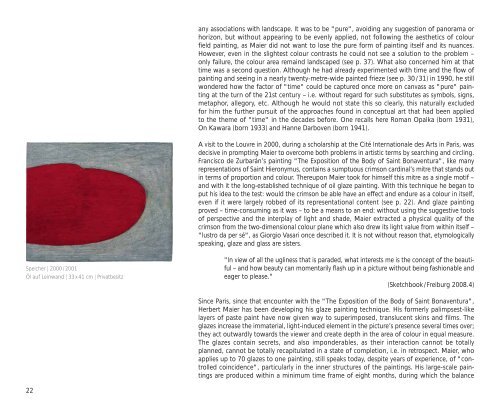Sie wollen auch ein ePaper? Erhöhen Sie die Reichweite Ihrer Titel.
YUMPU macht aus Druck-PDFs automatisch weboptimierte ePaper, die Google liebt.
Speicher | 2000 / 2001<br />
Öl auf Leinwand | 33 x 41 cm | Privatbesitz<br />
22<br />
any associations with landscape. It was to be "pure", avoiding any suggestion of panorama or<br />
horizon, but without appearing to be evenly applied, not following the aesthetics of colour<br />
field painting, as Maier did not want to lose the pure form of painting itself and its nuances.<br />
However, even in the slightest colour contrasts he could not see a solution to the problem –<br />
only failure, the colour area remaind landscaped (see p. 37). What also concerned him at that<br />
time was a second question. Although he had already experimented with time and the flow of<br />
painting and seeing in a nearly twenty-metre-wide painted frieze (see p. 30 / 31) in 1990, he still<br />
wondered how the factor of "time" could be captured once more on canvass as "pure" painting<br />
at the turn of the 21st century – i.e. without regard for such substitutes as symbols, signs,<br />
metaphor, allegory, etc. Although he would not state this so clearly, this naturally excluded<br />
for him the further pursuit of the approaches found in conceptual art that had been applied<br />
to the theme of "time" in the decades before. One recalls here Roman Opalka (born 1931),<br />
On Kawara (born 1933) and Hanne Darboven (born 1941).<br />
A visit to the Louvre in 2000, during a scholarship at the Cité Internationale des Arts in Paris, was<br />
decisive in prompting Maier to overcome both problems in artistic terms by searching and circling.<br />
Francisco de Zurbarán’s painting "The Exposition of the Body of Saint Bonaventura", like many<br />
representations of Saint Hieronymus, contains a sumptuous crimson cardinal’s mitre that stands out<br />
in terms of proportion and colour. Thereupon Maier took for himself this mitre as a single motif –<br />
and with it the long-established technique of oil glaze painting. With this technique he began to<br />
put his idea to the test: would the crimson be able have an effect and endure as a colour in itself,<br />
even if it were largely robbed of its representational content (see p. 22). And glaze painting<br />
proved – time-consuming as it was – to be a means to an end: without using the suggestive tools<br />
of perspective and the interplay of light and shade, Maier extracted a physical quality of the<br />
crimson from the two-dimensional colour plane which also drew its light value from within itself –<br />
"lustro da per sé", as Giorgio Vasari once described it. It is not without reason that, etymologically<br />
speaking, glaze and glass are sisters.<br />
"In view of all the ugliness that is paraded, what interests me is the concept of the beautiful<br />
– and how beauty can momentarily flash up in a picture without being fashionable and<br />
eager to please."<br />
(Sketchbook / Freiburg 2008.4)<br />
Since Paris, since that encounter with the "The Exposition of the Body of Saint Bonaventura",<br />
Herbert Maier has been developing his glaze painting technique. His formerly palimpsest-like<br />
layers of paste paint have now given way to superimposed, translucent skins and films. The<br />
glazes increase the immaterial, light-induced element in the picture’s presence several times over;<br />
they act outwardly towards the viewer and create depth in the area of colour in equal measure.<br />
The glazes contain secrets, and also imponderables, as their interaction cannot be totally<br />
planned, cannot be totally recapitulated in a state of completion, i.e. in retrospect. Maier, who<br />
applies up to 70 glazes to one painting, still speaks today, despite years of experience, of "controlled<br />
coincidence", particularly in the inner structures of the paintings. His large-scale paintings<br />
are produced within a minimum time frame of eight months, during which the balance


